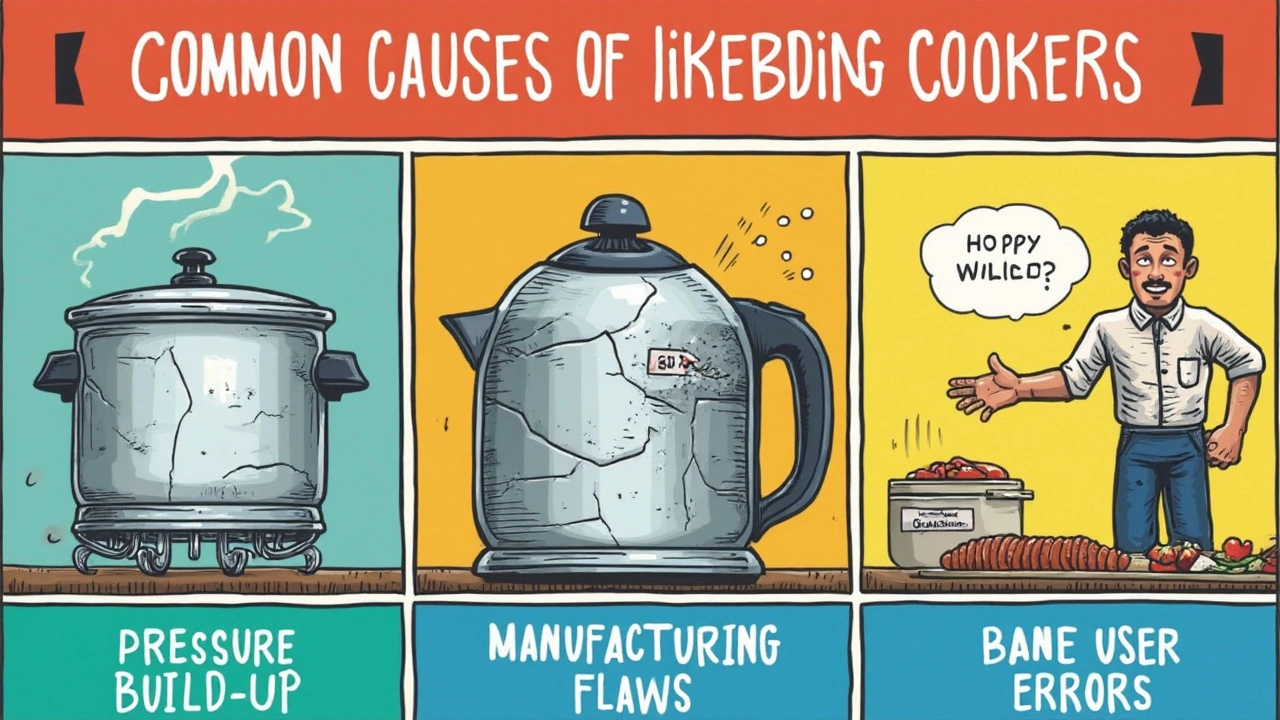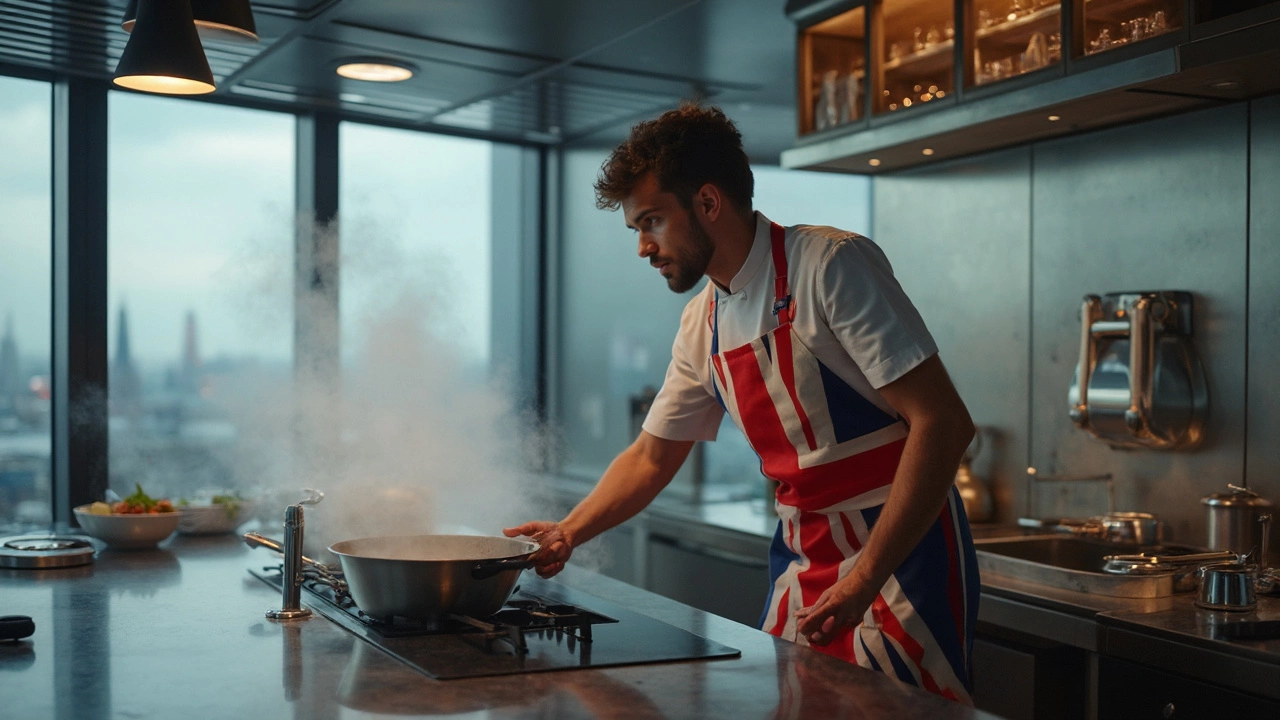Ever wondered why your cooker could suddenly burst and cause havoc in the kitchen? You're not alone. Cookers, especially pressure cookers, can be a ticking time bomb if not used correctly. And the causes? Yeah, they can be diverse, from pressure build-up to material flaws. Let's break it down.
First up, every cooker has a limit for how much pressure it can handle. If you pack yours to the brim or ignore its maintenance, pressure can sneak its way up and create risk. Think about it—would you ignore any high-pressure situation without control? Same thing here. It's crucial to read those guidelines, follow them, and know your cooker's boundaries.
- Understanding Cooker Mechanics
- Common Causes of Cooker Bursts
- Warning Signs to Watch
- Safety Measures and Prevention
- Steps to Take After a Cooker Accident
Understanding Cooker Mechanics
Have you ever stopped to think about what's going on inside your cooker while you're just prepping your next meal? It's more than just heat and pressure. Cookers, especially those fancy pressure ones, work on a simple yet clever principle—trapping steam to build pressure, which in turn raises the temperature and cooks food fast.
How Pressure Cookers Work
So, let's break it down. You add liquid and your food into the cooker. As it heats up, the liquid turns to steam. But, the magic happens when that steam gets trapped, creating pressure. This pressure spikes up the boiling point of water, so your food cooks at a higher temperature than usual. That's why it's quick and efficient.
Elements of the Cooker
- Pressure Valve: The hero of the story, it releases extra pressure, stopping your cooker from becoming a kitchen hazard.
- Sealing Ring: This little guy keeps the steam from escaping so the pressure can build.
- Locking Lid: Keeps everything shut tight, preventing any unwanted eruptions.
A point to remember—when things are working smoothly, cooker safety is not a worry. However, a faulty valve or a cracked ring, and you're dealing with potential risk.
Popular Cooker Types
Today, you've got a couple of options: electric pressure cookers, stovetop pressure cookers, and multi-cookers. Each has its own quirks and perks, but the mechanics remain largely the same. Consistent pressure management is key.
If you're going to play it safe, regular maintenance and knowing when something's off is vital. Listen for strange sounds, check for steam leaks, and, for heavens' sake, ensure your pressure valve is not clogged. These might seem like minor issues, but they could be the spark needed to turn a calm cooking day into a disaster.
Common Causes of Cooker Bursts
Dealing with kitchen accidents isn't fun, and understanding why cookers can burst is key to prevention. It's not just one thing but a mix of possible reasons.
1. Pressure Build-up
Most pressure cookers do what they say—use pressure to cook faster. However, if this pressure goes unchecked, it spells trouble. Manufacturers have safety features, but ignoring those or not following instructions can result in too much steam and, eventually, a burst.
2. Blocked Valves
The valve is like the cooker’s escape plan for excess pressure. If it's clogged, usually with food debris, the cooker can't release pressure properly, leading to potential disaster. Cleaning your cooker after every use is non-negotiable.
3. Poor Maintenance
Ignoring scratches or dents on your cooker isn't smart. Any structural issues can grow into bigger problems, especially under pressure. Regular checks can prevent nasty surprises.
4. Manufacturing Flaws
Sometimes, the fault is not the user’s but a design flaw. Checking for manufacturer recalls when buying a new cooker can save you some future trouble.
5. User Error
We all have moments of not reading the manual. Overfilling your cooker or using too little liquid can throw things off, causing those pressure problems.
Here's a quick glance (hypothetical) at reported causes based on a study:
| Cause | Percentage of Accidents |
|---|---|
| Pressure Build-up | 35% |
| Blocked Valves | 25% |
| Poor Maintenance | 20% |
| Manufacturing Flaws | 10% |
| User Error | 10% |
Knowing what's behind the problem helps you dodge unexpected kitchen chaos. Stay aware, stay safe, and keep cooking enjoyable!

Warning Signs to Watch
Spotting problems early with your cooker can save you a lot of trouble. But what exactly should you look for? Let's dive into some of the red flags that could signal an impending burst.
Unusual Noises
Does your cooker sound off with weird hisses or whistle more than usual? This could mean excessive pressure build-up, crying out for your attention. Don't just put it down to normal cooking sounds if it's persistent or unusual.
Sputtering Steam
Steam is supposed to escape from the valve in a controlled manner. If it's spurting erratically, it may indicate blockage or a malfunction. Keep an eye on that vent like a hawk during cooking sessions.
Deformed Cooker Lid
A lid that isn't fitting quite right is a major no-no. A warped lid can stop the cooker from sealing properly, which directly affects the safety features of a pressure cooker. Check those seals regularly.
Struggles to Maintain Pressure
If your cooker struggles or fails to build and maintain pressure, the gasket may be worn out, or there could be a more serious internal issue. This might lead to a higher chance of an unexpected burst, so make replacements as needed.
Visual Cracks or Leaks
Cracks or leaks are often early signs of cookers on their way out. Whether it's on the body, handle, or anywhere around, these weak spots can invite danger.
Always stay alert to these signs, and you'll ensure that your kitchen remains a safe zone. Prevention is key, and regular maintenance will help tackle potential problems before they escalate into real cooker accidents.
Safety Measures and Prevention
Alright, let's talk safety. When it comes to preventing your cooker from turning into a kitchen enemy, there's a lot to consider. Nobody wants a mini kitchen explosion ruining dinner—or worse, injuring someone. So, what can you do to keep things in check?
Regular Maintenance Is Key
First things first, stay on top of regular maintenance. Check your cooker for any signs of wear and tear, especially if it's starting to show its age. Gasket seals, vent pipes, and pressure regulators are the usual suspects, so give them a good look-over every few uses.
Don't Overfill Your Cooker
Another thing you can't ignore is the importance of not overloading. Seriously, check those max fill lines and respect them. More isn't always better, especially when it comes to potential pressure-related accidents. Keeping it under control helps prevent that unpredictable burst.
Pressure Release Matters
Next up, pay attention to how you release pressure. Quick-releasing steam recklessly? Yeah, that's asking for trouble. Follow your pressure cooker's manual for safe release methods, and let it cool down naturally when possible.
Quality Matters
You know what they say, quality over quantity. Choosing a reliable brand when buying your cooker means a lot less headache later on. Look for certifications and user reviews—take the time to invest in safety now to save a lot of hassle later.
Stay in the Kitchen
Finally, never leave your food cooking unattended. Sure, multitasking is the ultimate goal sometimes, but keep an eye on your cooker, especially when getting to know it or trying a new recipe. That way, if anything goes off track, you're there to fix it.
Pro Tip: Safety Features
Did you know that many modern cookers come equipped with safety features like automatic shut-off and pressure indicators? These can be your best friends in the kitchen. Make sure to familiarize yourself with these options and use them to your advantage.
A little attention goes a long way in preventing kitchen mishaps. Keep these tips at hand, stay informed, and you'll be on top of your culinary game without unnecessary risks.

Steps to Take After a Cooker Accident
If your cooker decides to go rogue and bursts, it’s chaos, but keep calm! There are specific steps you can take to manage the situation safely. Let's tackle them.
1. Immediate Safety Measures
First things first, make sure everyone in the vicinity is safe. If anyone is injured, seek medical help right away. Turn off any kitchen appliances, especially the stove, and evacuate if there's a risk of further incidents.
2. Ventilation
Open all windows and doors to let out any steam or smoke. This step is crucial to minimize inhalation of any potentially harmful fumes.
3. Cleaning Up
Once it's safe, wear rubber gloves to avoid burns or cuts from sharp debris. Carefully clean up any mess caused by the cooker to prevent anyone from slipping or getting hurt.
4. Inspect the Damage
Take a closer look at your pressure cooker. Identify any obvious faults or breakages. If possible, take photos for insurance or repair assessments. You’ll want to note down anything unusual.
5. Consult a Professional
Don’t try to fix the cooker yourself unless you’re a certified technician. Reach out to a cooker repair expert to evaluate what went wrong. It's the best way to prevent it from happening again. Using unaffected parts might be tempting, but it's often better to replace the damaged cooker altogether.
6. Report to Manufacturer
If you suspect a manufacturing defect, report it to the manufacturer. Some companies might offer replacements or official repairs, especially if they acknowledge the fault on their end.
7. Consider a Safety Course
If accidents seem frequent, consider a quick safety course on kitchen appliance handling. It's knowledge worth having if you're a frequent chef or just a safety bum.
Whether it's a slight scare or a major mishap, managing a post-accident scenario safely and efficiently can make all the difference. Safety first, always. And maybe a chocolate bar later to calm the nerves!


